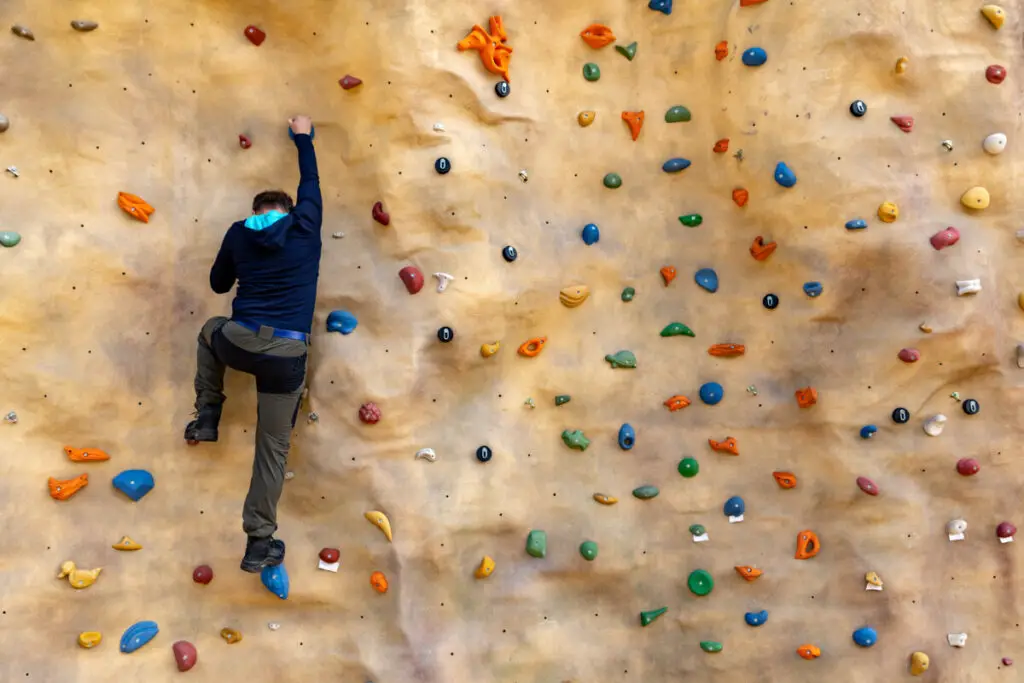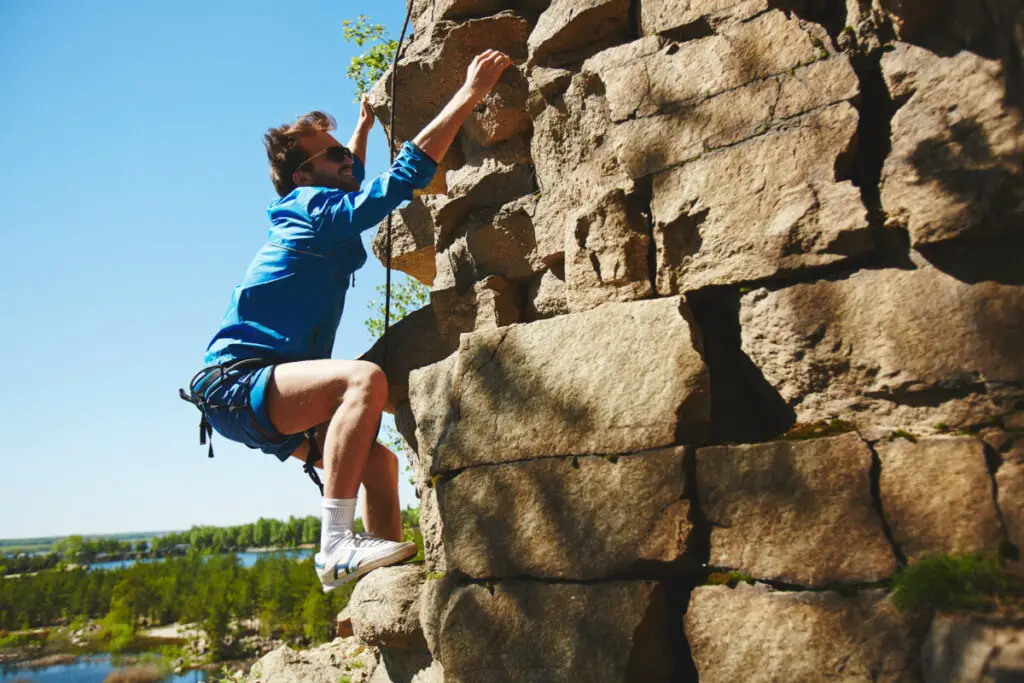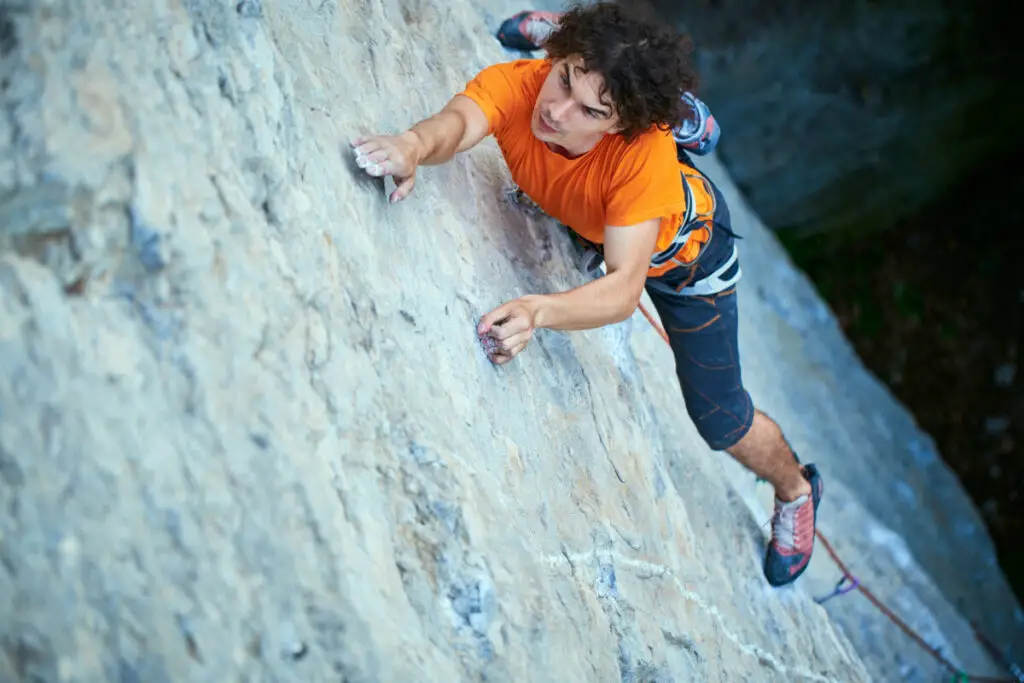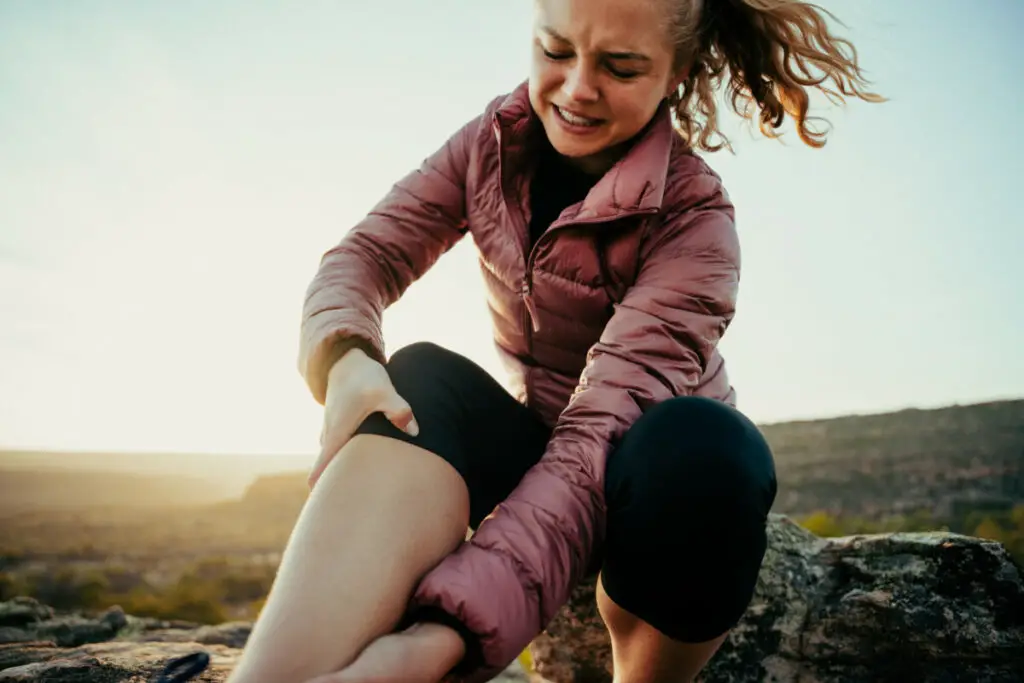
Rock climbing is a popular activity around the world, and enthusiasts are always looking for new friends to join them. Unfortunately, the high cost of climbing gear can be a deterrent. Are there climbing shoe alternatives that can be used instead?
There are no alternatives to climbing shoes that are fully safe or functional for extended use. Approach shoes are the best alternative for outdoor climbing or bouldering, and indoor climbing beginners can try water shoes or Converse. Some barefoot shoes may also work.
Beginners might be able to use alternative shoes for a short time, but there is no replacement for real climbing shoes. Keep reading below for more information on alternatives that can buy a new or young climber some time to save up.
Are There Climbing Shoe Alternatives That Work?
There are some climbing shoe alternatives that work well enough for beginners, people who climb casually and extremely rarely, and children, but anyone who falls outside of those parameters should invest in actual climbing shoes. This is for safety, not just for aesthetics.
Beginning climbers are usually on easy enough footholds that they can afford to use alternative climbing shoes without too much fear for their safety. It might not be easy to climb in Converse or water shoes, but it isn’t the worst idea, either.
The alternatives to climbing shoes that work for beginners and young children are:
- Converse, because they lace tightly and have thin rubber soles
- Water shoes, because they’re tight to your foot and have thin rubber soles meant for gripping
- Approach shoes, which are designed with occasional climbing in mind
- Classic trainers, which can work if laced tightly
- Barefoot shoes, which allow climbers to feel the rock and grip tricky footholds
What Alternatives to Climbing Shoes Can I Use for Outdoor Climbing?

Outdoor climbing offers sun, dirt, and gorgeous views, but it also presents more potential hazards to would-be climbers. It is even more important for outdoor climbers to make sure their feet are protected from sharp rocks and roots. With this in mind, some alternative climbing shoe options are better than others.
Barefoot Shoes
Barefoot Shoes are a surprising option for climbing since their shape is the literal opposite of most climbing shoes, but they’re still decently popular. They offer more protection than actually climbing barefoot, but their ultra-thin soles and overall design let climbers grip their toes onto rocks and ledges for a better overall experience.
Vibram Five Fingers is a popular brand recommended by barefoot shoe enthusiasts. People who have used them for climbing report finding them a little stiff, but comfortable and manageable.
Approach Shoes
Approach shoes combine many of the best aspects of climbing shoes, hiking boots, and mountaineering boots into something entirely unique. They’re meant to take on any terrain without flinching. If you want to go somewhere amazing and only have the budget for one pair of shoes, these might be the ones for you.
Best of all, there is a huge variety of approach shoes that can vary to meet your specific needs. You can choose if you want shoes best for climbing, scrambling, cragging, or general mountaineering with the occasional foray into climbing. Whatever you choose, these will keep you safe and sound.
Water Shoes
In all honesty, water shoes are not the best climbing option. However, they’re cheap and easily accessible. For someone experimenting with climbing, they can be a decent short-term option.
Basic Trainers
If you’re only going rock climbing once in a blue moon, classic trainers/sneakers are fine to use. Lace them securely and stay in easy areas to reduce the risk of injury.
What Alternatives to Climbing Shoes Can I Use for Indoor Climbing?
Indoor climbing presents some different needs and challenges when compared to outdoor climbing. There isn’t as much dust or dirt, but that means your shoes need to be cleaner and ready to share a space with others. Some shoes are better suited to an indoor climbing gym.
Barefoot Shoes
Barefoot shoes are just as good for an indoor climbing gym as they are for outdoor rock climbing. While they’re still opposite of a classic climbing shoe by nature of their design (splaying toes instead of pulling them into one grip point), they offer freedom of movement that keeps them suitable for climbing.
Water Shoes
Water shoes are better for indoor climbing than outdoor climbing. They allow climbers to get some grip without the risk of damaging the shoe on rough rocks and cliffs. They’re still not ideal, but they’ll work.
Converse Sneakers
Converse sneakers have thin rubber soles, a narrow shape, and the ability to lace tightly against the climber’s foot. They’re not great for climbing, but they’ll work well enough in a pinch.
Clean Trainers Laced Tightly
Clean trainers, and the emphasis should be on clean, can be decent indoor climbing shoes for a beginner who won’t get too far anyways. The biggest concern is that dirty shoes bring grime and germs into a shared environment, making things gross and slippery for others who follow. Make sure your shoes are clean before climbing.
What Alternatives to Climbing Shoes Can Kids Use?
Kids have some different options for alternatives to climbing shoes than adults do. Their feet are small enough to use smaller footholes without struggle, they already need to stay on easy paths, and their parents are unlikely to spend $40 on a pair of shoes that their kid will outgrow in a few months anyway.
However, parents should remember that kids are still very impressionable. If they remember scary, slippery, unstable footholds when they think of climbing, they’ll be more averse to it in the future. Parents who are serious about climbing may need to dish out the money to rent or buy real kids’ climbing shoes. For everyone else, these options should work fine.
Water Shoes
Many kids climb in water shoes. These shoes are meant to grip onto slippery underwater rocks to avoid dunking your kids, so they do pretty well with easy climbing.
Additionally, the soles are thin enough to provide tactile feedback without being so thin that they put the kid’s foot at risk of injury. The balance of protection and sensory input is helpful when teaching kids to climb.
Finally, they are cheap. If your kid tends to lose things, especially shoes, this might be the selling point for your family.
Kids’ Converse
Kids’ Converse are mainly favored because they lace so securely. They won’t spin around and cause chaos when your child steps a little funny, they won’t fall off halfway up the rock wall, and they won’t get left behind when you leave for home. When you’ve got a few chaotic tiny humans accompanying you on your trip, those are good things to think about.
Besides that, Converse can be a little tricky for kids to wear. The thin soles don’t feel as thin when you’re a child. Grip is the only other thing they really have to offer, and even that is varied.
If your child already has Converse, let them try climbing in them and see how it goes. If not, kids’ climbing shoes cost about as much as kids’ Converse do, so you might as well get the specialized product.
Kids’ Sneakers Laced Tightly
Kids’ sneakers are cheap, easy, and replaceable. If you want to get your child into climbing, they’re an easy way to start. You don’t have to worry about scuffs, tears, or anything if you’ve used a hand-me-down or thrift shop pair.
The biggest concern with kids’ sneakers is that they can be a little slippery on their little feet. Kid feet are often boxy, so shoes slip and trip them up. This can be scary for a little kid who’s just learning how to climb for the first time and already isn’t sure of themselves.
Let your kid test out sneakers/trainers and see how they do. If they get serious about climbing later on, you can get them kids’ climbing shoes. Until then, sneakers work just fine.
What Makes Climbing Shoes So Special?

Climbing shoes aren’t like ordinary sneakers. They have a specialized shape that helps climbers grip onto toe or heel holds, feel the rock under their feet, and stay safe while climbing. A quality pair of climbing shoes make the whole experience easier and more pleasant.
So, what exactly is it that makes climbing shoes so special compared to other outdoor and athletic shoes?
Narrow Toes
Serious rock climbers are often presented with tight, shallow, tricky footholds. Normal shoes would never be able to manage them, but rock climbing shoes are made with this problem in mind. Advanced shoes offer narrow pointed toes that allow climbers to put all their weight in one tiny area without slipping.
While this is useful, it is also extremely uncomfortable for anyone who hasn’t adjusted to this type of shoe and built up the necessary muscle. Beginners would be fine in a much more basic flat-soled shoe, or even in one of the shoes listed above as they adjust and experiment with climbing.
Downward Pointing Toes
Much like a ballerina’s point shoes, downward-pointed climbing shoes serve a specific purpose. They put all the climber’s weight and force onto a single point, allowing more strength in each step or hold. This allows the climber to pull off more challenging movements than they otherwise would have been able to accomplish.
Extremely Grippy Rubber
Climbing shoes can be weird to feel or see because of how grippy they are. The soles of the shoe almost feel squishy, leading to terms like “smear” and adjectives like “buttery” when people describe how the shoes work and what you can do with them. While these terms might make a climbing newcomer feel a little uncomfortable, they reflect one of the most important aspects of climbing shoes that new climbers shouldn’t ignore.
When new climbers choose a hiking shoe, a grippy sole should be a priority. That is the thing keeping the climber on the rock. At the end of the day, all other elements can quickly end up secondary to this.
Various Levels of Sole Stiffness
Climbing shoes offer a wide range of sole stiffness. This allows for strong structured shoes that take some of the strain off a climber’s legs while they balance on toes, as well as incredibly soft and malleable shoes that give a huge range of movement. This is something that is valuable for all climbers and is not properly offered in most alternative shoes.
The “Rubber Sock” Fit
The general climbing rule of thumb is that good climbing shoes should fit like a rubber sock. Regardless of the sole structure, toe shape, heel stiffness, or anything else, the shoe as a whole should still fit into that “rubber sock” guideline.
The reason is that this gives the best support, tactile feedback, and grip on the climbing surface. You won’t worry about your shoe slipping and sliding around if it fits like a sock. You’ll always know exactly where your feet are in space, and that’s valuable.
What Are the Risks of Using Alternative Shoes for Climbing?

The biggest concern when using alternative shoes is that they’re not engineered for climbing safety in the way that specialty shoes are. Specialty climbing shoes are made to make sure climbers can get a good grip, keep their weight centered, not get a sprain while climbing, and more. Any deviation brings some level of risk with it.
- You’re More Likely to Slip
- Shoes without the intense grip of a climbing shoe can’t hold on to rock walls and footholds as well. When climbing in less specialized shoes, you’re in danger of slipping.
- You Can Get a Sprain
- Shoes without the “rubber sock” fit are more likely to twist around on your foot after you take a bad step, putting you in danger of a sprain. Rock climbing is not the time that you want to get a sprained foot or ankle.
- You Can’t Sense Footholds as Well
- Thick soles and space in the toe box of shoes make it difficult to sense good footholes. Even if you feel sturdy, you might struggle to gauge where exactly your foot is and how much tolerance the foothold has. Professional shoes avoid that problem.

